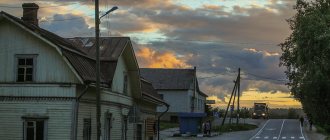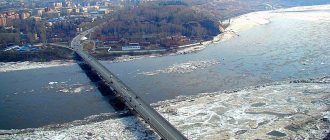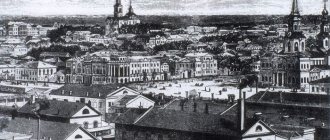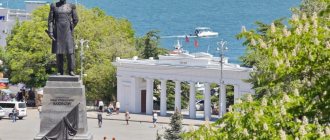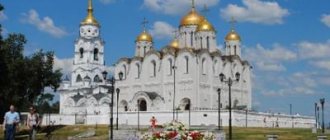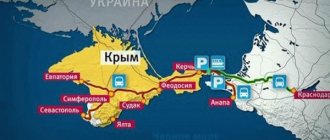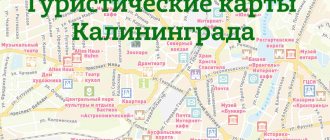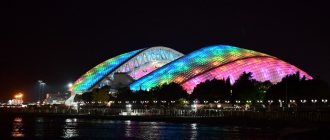Good afternoon, dear reader.
In this article we will talk about state registration plates (car license plates) . The numbers are assigned to the car during its registration with the traffic police and remain in place until one of the next owners decides to replace them, or the car’s registration is terminated.
Registration marks are unique, i.e. Two different cars cannot have the same number plates at the same time. The numbers always differ by at least one letter or number. Today we will look at the features and procedure for issuing license plates, as well as automobile region codes on the license plates.
The procedure for issuing license plates in Russia
Let's consider the most common type of numbers in the Russian Federation:
These are the numbers that are installed on most cars.
At first glance, the number consists of a random sequence of letters and numbers. In fact, not everything is so simple here.
All numbers from 0 to 9 are used on license plates. However, unlike numbers, not all letters of the Russian alphabet can appear on license plates. This privilege is given only to those letters that have similar spellings in the Latin alphabet. Those. Only the letters A, B, E, K, M, N, O, R, S, T, U, X can be used on license plates.
You might have learned about this fact before, but the next thought will probably seem interesting to you. We will talk about the order in which the numbers are issued .
Numbers are issued in order (except for special series). However, the order in which the characters change in the number is far from normal perception. The symbols change not from right to left, but in a slightly different way - in a rather confusing sequence.
1. Most often, the third digit in the license plate changes (in the figure it is number 6). After the number T356OK the number T357OK will be issued.
2. The second most frequently changing character is the 2nd digit (in Figure 5). After the number T359OK the number T360OK will be issued.
3. The third most common symbol is the 1st digit (in Figure 3). After the number T399OK the number T400OK will be issued.
The numbers seem to be okay, but the same cannot be said about the letters.
4. The fourth most common symbol is the 1st letter (T in the picture). After the number T999OK the number U001OK will be issued.
5. The fifth most common symbol is the 3rd letter (K in the picture). After the number X999OK the number A001OM will be issued.
6. The sixth most common symbol is the 2nd letter (O in the picture). After the number X999OX the number A001PA will be issued.
The procedure is quite complicated, so if you didn’t understand it the first time, re-read points 1-6 again.
The symbols on the left side of the registration plate, which were discussed above, are responsible for vehicle numbers within a specific region. By the way, I inform statistics lovers that no more than 1 million 726 thousand 272 car registration plates can be issued with one region code.
After this limit is exhausted, the number of the Russian region written on the right side of the number changes. From this moment on, numbers begin to be issued again within the new region. Each subject of the Russian Federation has its own code, and some subjects of the federation, which have a very large number of cars, are assigned several region codes at the same time.
Kaluga
Attractions
Train Station
The Kaluga station building was built in 1898. The external decoration of the building has retained its original appearance. In the summer of 1964, the first electric train from Moscow arrived here. Now you can get from Moscow to Kaluga in 3 hours.
Monument to K.E. Tsiolkovsky on Peace Square
In this house K.E. Tsiolkovsky lived for almost 30 years (from 1903 to 1933). On the first anniversary of the death of K.E. Tsiolkovsky, a scientific memorial museum was opened there. During the occupation of Kaluga, the Nazis destroyed the museum, but two months later it was restored and again opened its doors to visitors.
A stone bridge
This unique structure was built by architect P.R. Nikitin in 1777-1778. The length of the bridge is more than 100 meters, it stands on 15 stone arches, three of which are two-story. There is a legend that in the old days, girls in love jumped from this bridge without meeting their feelings in return.
Alekseevskaya Church
Alexeyevskaya Church was known as the Church of St. Alexey Metropolitan. The church was built in honor of the Metropolitan of the Russian Church Alexei, who lived in the 14th century. He headed the church during the difficult years of the Mongol-Tatar yoke (1354-1378). Under the Moscow prince Ivan Ivanovich the Red, he actually headed the government.
Initial information about the Church of Metropolitan Alexei dates back to the beginning of the 17th century. At that time its location was different. It was located in the city and in the city inventory of 1626 it was listed as follows: “Temple of the Drevians, Kletzki in the city.” The stone church was built on the site of the wooden one already in 1740. After the introduction of the new plan, the church was moved to what was then Yamskaya Sloboda.
According to D.I. Malinin, the church stood out for its appearance: simplicity of architecture and “a high tent roof, which is crowned with one dome. Bell tower in the “Italian style”.
There were three thrones in the temple:
- In the name of all saints;
- Alekseevsky chapel;
- Chapel of Kirik and Iulita.
The church possessed an icon of the Kazan Mother of God, which gave healing to the sick.
The church has not survived to this day. During the construction of multi-story buildings, it was demolished in the 50s. The place where she was located was the intersection of Kalyaev and K. Liebknecht streets.
Arkhangelsk Church
It was known as the Church of the Archangel Michael. The church is dedicated to the Archangel Michael, the heavenly military leader, the guardian angel of all believers in Christ.
According to the inventories of V.G. Pleshcheev in 1626 and 1685, it was listed as wooden, with a side chapel in the name of Ts. Constantine, in the old prison. In 1687, a stone five-domed church with a refectory and a chapel in the name of John the Warrior was built. After the fire of 1754, it was rebuilt in 1760.
The bell tower was built in 1813 by Ya.I. Bilibin.
According to the stories of D.I. Malinin, the real temple was decorated on all four sides with porticoes on high paired columns with trimmed capitals. In the pediments there is a sacred image: on the altar apse the Archangel Michael is depicted, on his sides there are two columns, and above him is a holy painting.
The bell tower had 3 tiers, octagonal, the second and third tiers had pediments supported by a pair of columns, one on each side. Above the third tier there were round windows-voices.
Among the church values the following stood out:
- Gospel of the Moscow seal of 1644;
- Two bells - 1617 and 1771
The church was very popular among the military of the Kaluga garrison. In 1915 - 1917 - regimental, military church.
The church has not survived to this day. The Church of St. Michael the Archangel was dismantled in 1935, and a house was built in its place. Lenina, 100.
Annunciation Church
According to Malinin, it was first listed in the inventory of 1685. In 1718, parishioners built a stone church. And in 1826 a bell tower was built.
The temple was of architectural interest.
It has not survived to this day. Now on this site there is a park named after A. Karpov. The church itself was dismantled in the 30s. XX century and its material was used to build a kindergarten and a bakery.
Epiphany Church
The Church of the Epiphany, according to Malinin, existed at the beginning of the 17th century. In 1626, this church was described as the Epiphany Church with a chapel in the name of Great Martyr Barbara with a chapel in the name of St. Nicholas, wooden, with 7 bells.
The stone one was built by parishioners in 1735 with two chapels in the name of Athanasius of Alexandria and Our Lady of “All Sorrowful Joys.” The new bell tower was built in 1832.
The temple, built in the style of classicism, according to the architect V.M. Fekhner, is distinguished by its “solemn monumentality.” The church has the shape of a cube. On the sides of the cube there is an elongated semicircular middle with a picturesque image; above the dome there is a light large octagon with a round dome; cross - with a small crown.
The bell tower is three-tiered, tetrahedral.
According to D.I. Malinin, there were a lot of ancient icons of the 16th century in the temple. and the 17th century. Among them, the icon of the Great Martyr Barbara, the icon of St. Sergei of Radonezh, the Tikhvin, the Resurrection of Christ, the Epiphany, and St. Nicholas the Wonderworker icons were revered.
The church has survived to this day. During the renovation of the church, it turned out that the walls of the temple and the bell tower were in very poor condition. The church is gradually being destroyed. You can see her on Kutuzov Street.
Vasilyevskaya Church
People called it Trinity. According to the inventory of 1626, it was listed as “The Church of St. Basil the Great in the fort and on the settlement.” In 1742, it was built in stone and was located in the square near the Nikitsky Church, on a place known as the Nikitsky cemetery. But due to dilapidation and according to the new city plan, in 1801 it was moved to the place where it now stands. At this place in the 18th century. there was a cemetery. And often tombstones were found behind the altar. The benefactor of this church was Metropolitan Jonah. He often donated more than 20 thousand rubles in silver. With his funds, a bell tower was built in 1830, the temple was painted, and many things were purchased.
This church has survived to this day. Now it is located on Herzen Street and is called Vasilyevskaya Church.
State Museum of the History of Cosmonautics named after K. E. Tsiolkovsky
The State Museum of the History of Cosmonautics named after K. E. Tsiolkovsky in Kaluga is the first in the world and the largest space museum in Russia, created with the direct participation of S. P. Korolev and Yu. A. Gagarin.
On June 13, 1961, Yu. A. Gagarin laid the first stone in the foundation of the building of the future museum. The museum was opened to visitors in 1967.
In 1960, the museum was designated a scientific and methodological center for coordinating the activities of space museums in the USSR, and in 1979 it received the status of a research institution. In 1993, the State Museum of the History of Cosmonautics named after K.E. Tsiolkovsky was classified as one of the largest cultural and educational institutions of particular social significance.
The museum's exhibitions reveal the history of aeronautics, aviation, and rocket and space technology. The scientific heritage of Konstantin Eduardovich Tsiolkovsky, the founder of theoretical cosmonautics, a major inventor, and author of works on philosophy and sociology, is comprehensively presented. Images of the technology of the future (airplane, airship, rocket, ethereal settlements) substantiated by the scientist are presented.
The house-museum of Konstantin Eduardovich Tsiolkovsky, the great Russian scientist, founder of theoretical cosmonautics, is located on the outskirts of the city of Kaluga near the Oka River. 29 years of the scientist’s life are associated with this house. Here he wrote dozens of important works on aeronautics, aviation, jet propulsion, astronautics and other problems.
Theaters
Kaluga Municipal Experimental Youth Theater-Studio "TYUZ", Kaluga Regional Drama Theatre, Kaluga Puppet Theater.
Story
The history of Kaluga is connected with the formation of the Moscow Principality. The city was founded in the mid-14th century under the Moscow prince Simeon Gord as a border fortress on the southwestern borders of the Moscow state. It was first mentioned in 1371 in a charter of the Lithuanian prince Olgerd. The Simeonovo settlement, where the fortress was originally located, occupied a peninsula on the Yachenka River, where, perhaps, the name of the city comes from - the popular word “kaluga” means “peninsula”. At the end of the 14th century, Kaluga became part of the Mozhaisk Principality. In the 14th-16th centuries, Kaluga was a fortress in the defense system of the Moscow principality along the Oka and Ugra rivers (“Belt of the Virgin”). In 1606-1607, Kaluga found itself in the thick of events of the uprising led by Ivan Bolotnikov. In 1708, Kaluga became part of the Moscow province. Since 1777 - the center of the Kaluga governorship (then the Kaluga province). The events of the Patriotic War of 1812 are connected with Kaluga. Near the village of Tarutino, Kaluga province, Russian troops led by M.I. Kutuzov were preparing to expel Napoleon from Russia. During the Great Patriotic War, Kaluga was occupied by the Germans from October to December 1941.
The architectural appearance of Kaluga is distinguished by the variety of styles of surviving buildings. Until the 1760s, wooden buildings predominated in Kaluga. The only known monument of civil architecture in Kaluga from the late 17th century is considered to be the house of the merchant Korobov (Korobov's chambers), which was distinguished by complex decorative treatment of the residential roof and a wooden gallery on stone pillars. Stone city churches from the late 17th to the first half of the 18th century demonstrate the stability of the architectural traditions of the mid-17th century. These include the Church of the Intercession on the Moat (1687), built next to the fortress, the complex cornice of which, supporting a number of decorative kokoshniks with a keeled finish, is characteristic of Russian architecture of the first half of the 17th century. The Church of St. George at the Top (1700-1701) is interesting for its decor and complex composition, as well as carved white stone portals of the entrances to the upper and lower church.
The historical center of the city is the Berezuisky ravine located on the left bank of the Oka, near which the Kaluga Kremlin, which burned down in 1700, was located. In 1780, the architect P.R. Nikitin built the Berezuisky Bridge on high, powerful arches (now with a cast-iron lattice from the 19th century). Near the bridge is the Makarov House, built in 1738 and retaining many features of its original appearance. The main decoration of this house is the light and two-tier porch-balcony.
In the 1780s, the construction of the main “state buildings” was carried out, among which the Government Offices (1778-1787), the Noble School (1779, now the Pedagogical Institute), the post office (1782), and Gostiny Dvor (1782-1796) stand out. Among the civil buildings, the estate of the merchant Zolotarev (1805-1808) stands out, decorated with cast-iron lace gates and lanterns symmetrically located at the entrance. Now it houses the Kaluga Regional Museum of Local Lore, one of the oldest in Russia. The interior decoration of the house was made at the beginning of the last century by the Moscow workshop of S. P. Campioni. Residential buildings in Kaluga, built in the 19th century, are mainly designed in the classicist style. These include the Falev house, the Timchenko estate, the Goncharov house, and one of the estates of the Bilibin family. An example of Empire architecture is the Meshkov House (1826).
The names of the Decembrists P. N. Svistunov, G. S. Batenkov, E. N. Obolensky, who lived here after returning from Siberian exile, are associated with Kaluga. The Kaluga land remembers G. R. Derzhavin, N. V. Gogol, the Kireevsky brothers, F. M. Dostoevsky, A. P. Chekhov, L. N. Tolstoy, K. A. Tolstoy, P. A. Kropotkin. In Kaluga lived the mathematician P. L. Chebyshev, a native of the village of Okatovo, Borovsky district. Actors M. S. Shchepkin, P. S. Mochalov, G. N. Fedotova, M. G. Savina performed on the stage of one of the oldest provincial theaters in Russia - Kaluga.
Since 1892, K. E. Tsiolkovsky lived in Kaluga, and the house-museum is dedicated to his memory. The Kaluga Museum of the History of Cosmonautics bears the name of Tsiolkovsky. In the 1920s, the founder of heliobiology, A.L. Chizhevsky, worked in Kaluga. Theatrical and musical traditions of Kaluga continue their development in the Lunacharsky Drama Theater and in the regional philharmonic society. Kaluga became famous for its music and dance groups, such as the Male Academic Choir, the Molodost and Kalinka ensembles. The Kaluga Art Museum was created in 1918 on the basis of a collection of paintings by Kaluga doctor N. I. Vasiliev, which he donated to the city.
In the village of Romodanovo near Kaluga there is a five-domed Church of the Nativity of the Virgin Mary (1691). Close to the city limits is the Eropkin estate in Grabtsevo, built in the pseudo-Gothic style (late 18th - early 19th century, rebuilt at the end of the 19th century). In the immediate vicinity of Grabtsevo there is the estate of the princes Golitsyn in Gorodnya with a country palace (late 17th century). 18 km from Kaluga down the Oka River there is the Avchurino estate, known since the 15th century, with an architectural ensemble of the 18th - early 19th centuries. Russian emperors - Alexander I, Nicholas I, Alexander II - stayed in this estate.
Transport
City transport in Kaluga is represented by buses, minibuses and trolleybuses.
The Vyazma-Ryazhsk railway line passes through the city (Kaluga-1 railway station). The Moscow-Kyiv railway passes through a remote area of the city (Kaluga-2 railway station). The Kaluga-1 railway station serves mainly suburban railway traffic - electric trains (including express trains) to the Kievsky station in Moscow, electric trains to the Aprelevka station in the Moscow region, electric trains to Sukhinichi in the Kaluga region, diesel trains to the Fayansovaya station in the city of Kirov in the Kaluga region, Vyazma , the city of Aleksin, as well as diesel trains (express) to Tula and Uzlovaya 1 station in the Tula region. Also, the St. Petersburg - Tashkent train passes through the Kaluga-1 station, and in the summer season, a train from Moscow to Anapa. Long-distance trains to Bryansk and Ukraine pass through the Kaluga-2 railway station.
16 kilometers from the center of Kaluga there is the federal highway M3 “Ukraine”, which connects the city with Moscow, Bryansk, as well as with Obninsk, a science city located in the north of the Kaluga region.
Kaluga is connected with the capital and some cities of Russia by bus. The bus station is located in the same building as the Kaluga-1 railway station.
2021 and 2022 Automotive Region Code Table
| Code | The subject of the Russian Federation |
| 01 | Republic of Adygea (Adygea) |
| 02, 102, 702 | Republic of Bashkortostan |
| 03 | The Republic of Buryatia |
| 04 | Altai Republic |
| 05 | The Republic of Dagestan |
| 06 | The Republic of Ingushetia |
| 07 | Kabardino-Balkarian Republic |
| 08 | Republic of Kalmykia |
| 09 | Karachay-Cherkess Republic |
| 10 | Republic of Karelia |
| 11 | Komi Republic |
| 12 | Mari El Republic |
| 13, 113 | The Republic of Mordovia |
| 14 | The Republic of Sakha (Yakutia) |
| 15 | Republic of North Ossetia-Alania |
| 16, 116, 716 | Republic of Tatarstan (Tatarstan) |
| 17 | Tyva Republic |
| 18 | Udmurt republic |
| 19 | The Republic of Khakassia |
| 21, 121 | Chuvash Republic - Chuvashia |
| 22 | Altai region |
| 23, 93, 123, 193 | Krasnodar region |
| 24, 124 | Krasnoyarsk region |
| 25, 125 | Primorsky Krai |
| 26, 126 | Stavropol region |
| 27 | Khabarovsk region |
| 28 | Amur region |
| 29 | Arhangelsk region |
| 30 | Astrakhan region |
| 31 | Belgorod region |
| 32 | Bryansk region |
| 33 | Vladimir region |
| 34, 134 | Volgograd region |
| 35 | Vologda Region |
| 36, 136 | Voronezh region |
| 37 | Ivanovo region |
| 38, 138 | Irkutsk region |
| 39 | Kaliningrad region |
| 40 | Kaluga region |
| 41 | Kamchatka Krai |
| 42, 142 | Kemerovo region |
| 43 | Kirov region |
| 44 | Kostroma region |
| 45 | Kurgan region |
| 46 | Kursk region |
| 47, 147 | Leningrad region |
| 48 | Lipetsk region |
| 49 | Magadan Region |
| 50, 90, 150, 190, 750 | Moscow region |
| 51 | Murmansk region |
| 52, 152 | Nizhny Novgorod Region |
| 53 | Novgorod region |
| 54, 154 | Novosibirsk region |
| 55 | Omsk region |
| 56, 156 | Orenburg region |
| 57 | Oryol Region |
| 58 | Penza region |
| 59, 159 | Perm region |
| 60 | Pskov region |
| 61, 161, 761 | Rostov region |
| 62 | Ryazan Oblast |
| 63, 163, 763 | Samara Region |
| 64, 164 | Saratov region |
| 65 | Sakhalin region |
| 66, 96, 196 | Sverdlovsk region |
| 67 | Smolensk region |
| 68 | Tambov Region |
| 69 | Tver region |
| 70 | Tomsk region |
| 71 | Tula region |
| 72 | Tyumen region |
| 73, 173 | Ulyanovsk region |
| 74, 174 | Chelyabinsk region |
| 75 | Transbaikal region |
| 76 | Yaroslavl region |
| 77, 97, 99, 177, 197, 199, 777, 797, 799 | Moscow |
| 78, 98, 178, 198 | Saint Petersburg |
| 79 | Jewish Autonomous Region |
| 82 | Republic of Crimea |
| 83 | Nenets Autonomous Okrug |
| 86, 186 | Khanty-Mansiysk Autonomous Okrug - Ugra |
| 87 | Chukotka Autonomous Okrug |
| 89 | Yamalo-Nenets Autonomous Okrug |
| 92 | Sevastopol |
| 95 | Chechen Republic |
The Kaluga region is located 150-200 km southwest of Moscow. Formed in 1944.
The administrative center of the region is the city of Kaluga. The territory is 29.9 thousand km2, the population of the region is 1009.8 thousand people (2016), the population density is 33.9 people/km2 (2016), the share of the urban population is 76.25% (2015).
Geography
The Kaluga region borders on the Moscow, Tula, Bryansk, Smolensk, and Oryol regions.
From north to south, the region stretches for more than 220 km from 53° 30′ to 55° 30′ northern latitude, from west to east - for 220 km, the territory area is 29.9 thousand square meters. km. The most important international highways and railways pass through the territory of the region: Moscow - Kaluga - Bryansk - Kyiv - Lvov - Warsaw.
Natural resources
A significant part of the region's territory is covered with forests.
Deposits of brown coal, phosphorites, non-metallic building materials (limestone, sand, brick, ceramic and expanded clay, tripoli, chalk, mineral paints).
Agricultural land at the beginning of 2005 occupied 1,350 thousand hectares. Main crops: wheat, barley, rye, oats, buckwheat, flax, vegetables.
Climate
The region's climate is characterized by well-defined seasons: moderately hot and humid summers and moderately cold winters with stable snow cover. The average temperature in July is +(17-18) °C, in January - (9-10) °C. The warm period (with a positive average daily temperature) lasts 215-220 days.
The annual precipitation varies between 365-1000 mm.
Population
According to Rosstat, the population is 1,009,772 people. (2016), of which the urban population is 768,770 people. (76.1%), rural - 241,002 people (23.9%).
In 2010, the national composition of the region's population was as follows: Russians - 86.0%, Ukrainians - 1.7%, Armenians - 1.0%, Belarusians - 0.5%, Tatars, Azerbaijanis - 0.4% each, Uzbeks, Gypsies, Tajiks, Moldovans - 0.3% each, Germans, Mordovians, Georgians, Chuvash, Lezgins, Dargins, Gagauz, Koreans, Jews - 0.1% each, other nationalities - 7.9%.
Settlements with a population of more than 5 thousand as of January 1, 2015
| City | Population | City | Population | City | Population | City | Population |
| Kaluga | 342,9 | Kozelsk | 16,1 | Borovsk | 11,2 | Medyn | 7,9 |
| Obninsk | 111,4 | Kondrovo | 15,2 | Kremenki | 10,8 | Yukhnov | 6,2 |
| Lyudinovo | 39,2 | Sukhinichi | 15,1 | Vorotynsk | 10,6 | Duminichi | 5,7 |
| Kirov | 30,9 | Tovarkovo | 14,0 | Ermolino | 10,3 | Zhizdra | 5,5 |
| Maloyaroslavets | 28,1 | Zhukov | 12,8 | Tarusa | 9,3 | Detchino | 5,0 |
| Balabanovo | 25,4 | Sosensky | 11,2 | Belousovo | 8,9 | Polotnyany Plant | 4,8 |
Official symbols of the Kaluga region
Legacy area codes
| Code | The subject of the Russian Federation | Note |
| 20 | Chechen Republic | before 2000 |
| 80 | Transbaikal region | until 2022 |
| 81 | Perm region | until 2022 |
| 84 | Krasnoyarsk region | until 2022 |
| 85 | Irkutsk region | until 2022 |
| 88 | Krasnoyarsk region | until 2022 |
| 91 | Kaliningrad region | |
| 94 | Territories located outside the Russian Federation and served by the internal affairs bodies of the Russian Federation | until 2022 |
